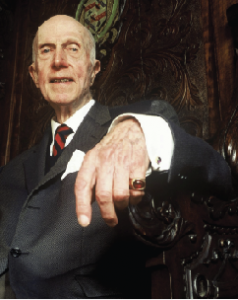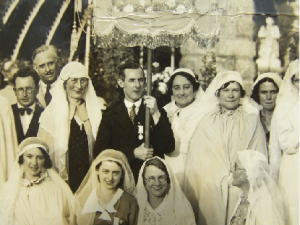TV Eye: The Raj in the rain
Published in Issue 6 (November/December 2013), Reviews, Volume 21The Raj in the rain
RTÉ1, 17 September 2013
Frank Duff agus an Léigiún Mhuire
Esras Productions
TG4, 11 September 2013
by John Gibney

The Raj in the rain was apparently filmed over a number of years and dealt with the remnants of the Protestant ‘Ascendancy’, the predominantly Anglican landed class who made up Ireland’s ruling élite from the conquests of the seventeenth century until they were effectively cast aside by the British state towards the end of the nineteenth century. A set of clichés tends to cluster around the group often termed the ‘Anglo-Irish’: chronic eccentricity, decayed mansions and the like. Their eccentricity is debatable; the decay of their estates less so. The ‘Big House’ remains a staple of Irish literature, both in its prime and in its decline.
The trajectory of the Ascendancy is straightforward: families, of varying antiquity and ethnic origin, who secured landed wealth in the sixteenth and seventeenth centuries, were predominantly Protestant (usually Anglican) and became progressively gentrified in the eighteenth century. Adherence to the established Church of Ireland was fundamental to their status, which was eroded in political terms from the end of the eighteenth century and in socio-economic terms from the end of the nineteenth. As the estates that sustained their iconic mansions were broken up under the land acts, their wealth was whittled away and their homes fell into disrepair, and their status declined even further after the establishment of the Irish Free State in 1922.

Patrick Cooney’s film focused on a handful of the remaining families, and he obviously won their trust. But his documentary was resolutely soft-focus, eschewing interpretation (at least in this condensed TV version; a longer version was shown at the Irish Film Institute earlier this year). While fascinating as an intimate portrait of the remnants of Ireland’s ruling class, such as Sir John Leslie of Castle Leslie, veteran of World War II and resolute clubber, The Raj in the rain proved frustrating on another level: there was little or no attempt to probe how the remnants of the Ascendancy fitted into the independent state that emerged from the 1920s onwards. The engagingly forthright Sir Josslyn Gore-Booth (formerly of Lissadell, Co. Sligo) struck a vaguely condescending tone towards the politics of his republican ancestor Constance Markiewicz, but he was very clear about his sense of himself as British, in the sense of membership of the British Empire. Some greater examination of the experience of the former Ascendancy, in terms both of how they viewed the new Ireland and of how it viewed them, would have strengthened this documentary (or at least this version of it) immeasurably. A natural companion piece is Jane O’Hea O’Keeffe’s recent Voices from the great houses: Cork and Kerry (Mercier Press, €19.99pb, 288pp, ISBN 9781781171318), which explores the world of landed Protestants in those counties in greater depth and to greater effect than Cooney’s film.
It was hard not to conclude that the film could have dug a little deeper. The occasional assertion went unchallenged. For example, the late Mark Bence-Jones of Charleville—himself an assiduous chronicler of the decay of the Ascendancy—struck a Yeatsian note when observing that artists of the calibre of Yeats and Elizabeth Bowen had arisen from the class of which he was a member, to which one might respond that many other artists of genius did not. Equally, Bence-Jones was adamant that he and his caste were, and are, Irish; the appellation ‘Anglo-Irish’ was a term applied by others. After centuries of residence in Ireland, who could reasonably argue otherwise? The Raj in the rain ended on a somewhat sombre note, with the sale of Lissadell and its surrounding grounds: a reminder that the sense of otherness engendered by affiliation to the British world and Protestantism is not automatically matched by prosperity, regardless of social status.
Given that The Raj in the rain dealt with the descendants of Ireland’s old Protestant ruling class, it seems appropriate to follow it up with a documentary that touches on what was perhaps the dominant ethos of Irish society after independence: Catholicism, in the form of Frank Duff. A humble and modest Dubliner, Duff became increasingly devout after joining the Society of St Vincent de Paul in 1913. He ultimately founded the Legion of Mary on Dublin’s Francis Street in 1921, and his story was told in Frank Duff agus an Léigiún Mhuire.

Right: Frank Duff with members of the Legion of Mary in Lourdes, 1934. (Legion of Mary)
Below: Frank Duff pointing out the various Legion of Mary senati throughout the world. Even in the twenty-first century the Legion retains a global reach. (Legion of Mary)
Duff conceived of the Legion as a Catholic lay organisation, driven by a Catholic sense of purpose. The 1932 Eucharistic Congress was a key factor in the global dissemination of the Legion, which even in the twenty-first century retains a global reach. But its origins were intertwined with the often-horrific social conditions of 1920s Dublin. Duff was concerned with material as well as spiritual poverty: in the 1920s he was the driving force behind the Cosgrave government’s drive to clear out the notorious red-light district of Monto in Dublin’s north inner city. Yet this was not just a moral crusade: Duff’s determination to wipe out prostitution was also driven by a firm sense of social justice. His establishment of the Regina Coeli home for unmarried mothers and their children, and the Morning Star hostel for homeless men, suggested a liberal and progressive stance on social issues that was not automatically shared by the Catholic clergy. The Catholic Church almost acted as a parallel state in Ireland, and figures such as John Charles McQuaid most certainly disapproved of some of Duff’s activities; an authoritarian territorialism prevailed, as the clergy sought to resist such encroachments from the laity. Duff’s pioneering attempts at ecumenical and inter-faith dialogue with Protestants and Jews, for instance, were swiftly stamped out.
In both style and tone, this pedestrian production seemed a throwback to an earlier time. It also seemed to gloss over some salient features of Duff’s life. It is extraordinary that, while much was made of how much he enjoyed cycling, there was virtually no mention of something that he was far less enthusiastic about: the industrial school system. Perhaps the image of a devout Catholic such as Frank Duff criticising a system presided over by the church of which he was a member might have complicated things. HI
 John Gibney is the on-line editor of History Ireland.
John Gibney is the on-line editor of History Ireland.
















